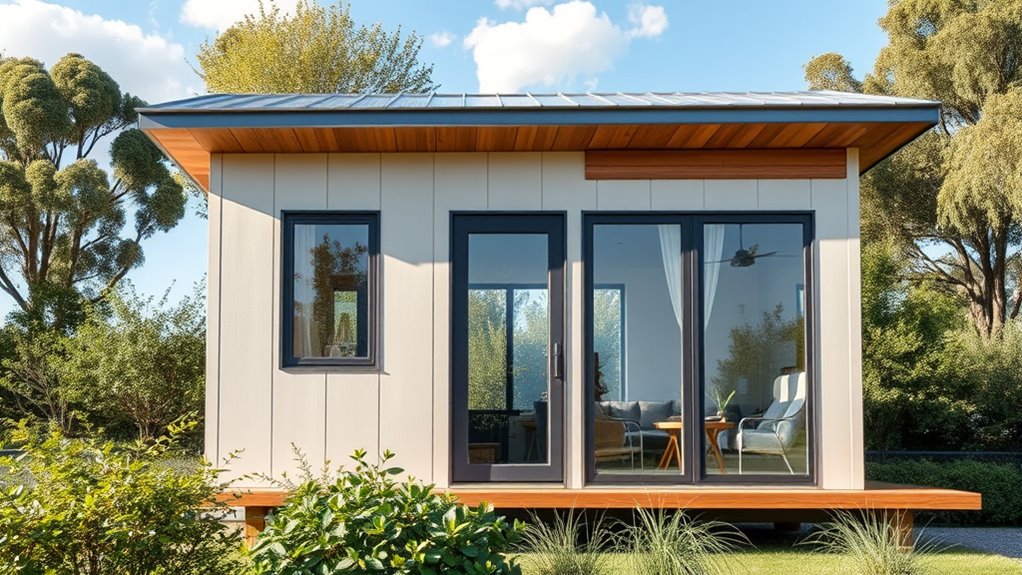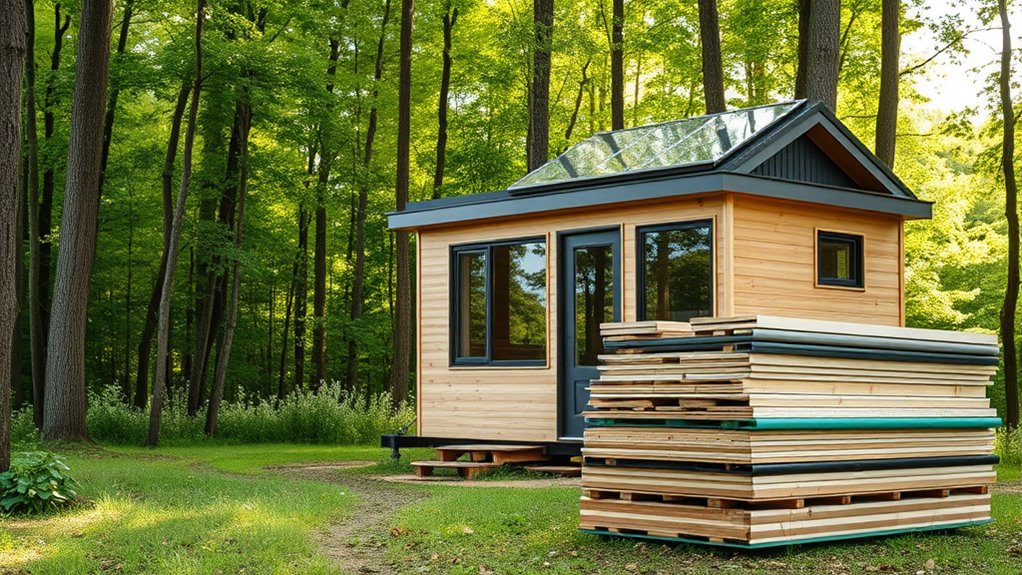For lightweight tiny houses, opt for durable materials like recycled steel frames or bamboo, which are eco-friendly and easy to transport. Use advanced insulation options such as spray foam or rigid foam boards to improve energy efficiency without adding extra weight. These materials help maintain structural integrity, reduce environmental impact, and support mobility. Plus, combining these choices guarantees your tiny home stays sustainable and sturdy—discover more ways to optimize your build by exploring further details.
Key Takeaways
- Use advanced insulation materials like spray foam or rigid foam boards for superior thermal performance and lightweight properties.
- Incorporate recycled steel frames for durability, pest resistance, and a low carbon footprint.
- Opt for sustainable, rapidly renewable materials such as bamboo for framing to reduce environmental impact.
- Choose lightweight, eco-friendly materials that facilitate easy transportation, assembly, and disassembly.
- Enhance efficiency with additional features like air purifiers and high-performance insulation for long-term sustainability.

When building lightweight tiny houses, choosing the right materials is vital for guaranteeing portability, durability, and energy efficiency. You want materials that not only keep the structure lightweight but also provide excellent insulation and sustainability. One of the most effective ways to achieve this is by incorporating innovative insulation solutions. Modern insulation materials, such as spray foam or rigid foam boards, offer superior thermal performance while remaining lightweight. These materials minimize heat transfer, helping you maintain a comfortable interior temperature without adding unnecessary bulk. Plus, innovative insulation options often come with eco-friendly credentials, making your tiny house more sustainable overall.
In addition to insulation, sustainable framing plays a key role in building lightweight tiny houses. Traditional framing methods can be heavy and resource-intensive, so opting for sustainable framing options is a smart choice. You might consider using recycled steel or bamboo, which are both lightweight and environmentally friendly. Recycled steel frames are incredibly durable, resistant to pests and rot, and can be manufactured with a lower carbon footprint. Bamboo, on the other hand, is a rapidly renewable resource that offers excellent strength-to-weight ratios. It’s also biodegradable and requires less energy to harvest and process compared to conventional wood framing. Incorporating these sustainable framing options helps reduce the environmental impact of your tiny house project while guaranteeing structural integrity.
When selecting materials, keep in mind that lightweight doesn’t mean sacrificing quality. The combination of innovative insulation and sustainable framing ensures your tiny house remains sturdy yet easy to transport. Lightweight materials also make assembly and disassembly simpler, which is perfect if you plan to move your tiny home frequently. Remember, the goal is to create a structure that’s as eco-friendly and energy-efficient as possible without adding unnecessary weight or complexity. This means focusing on high-performance insulation and sustainable, lightweight framing options that can withstand the elements and last for years.
Ultimately, choosing the right materials for your tiny house involves balancing weight, durability, and sustainability. By integrating innovative insulation and sustainable framing, you set yourself up for a successful project that’s both environmentally responsible and highly functional. These choices will help you build a tiny home that’s easy to move, cost-effective to maintain, and comfortable to live in—all while minimizing your ecological footprint. Including advanced insulation technology can further enhance energy efficiency and comfort in your tiny home.
Frequently Asked Questions
Are Eco-Friendly Materials More Cost-Effective for Tiny Houses?
Eco-friendly materials can be more cost-effective for your tiny house in the long run, thanks to sustainable cost savings. They often reduce energy bills through better insulation and energy efficiency, and may require less maintenance over time. While upfront costs might be slightly higher, your eco-friendly choices lead to savings on utilities and repairs, making them a smart investment. Ultimately, these materials benefit both your wallet and the environment.
How Do Materials Affect the Insulation Quality in Tiny Houses?
Materials directly impact your tiny house’s insulation performance and material permeability. Using high-quality, insulating materials like spray foam or rigid foam boards improves thermal efficiency, keeping you warm in winter and cool in summer. Permeability affects moisture control; selecting breathable materials like cellulose or mineral wool helps prevent mold and condensation, ensuring a healthier, more comfortable living space. Your choice of materials is vital for essential insulation and durability.
Can Lightweight Materials Withstand Extreme Weather Conditions?
Yes, lightweight materials can withstand extreme weather conditions if you choose weather-resistant and durable options. Materials like fiber-reinforced polymers, treated wood, and high-quality composites offer excellent durability and resistance to rain, wind, and temperature fluctuations. By selecting these materials, you guarantee your tiny house remains resilient during harsh weather, providing safety and longevity without adding unnecessary weight. Properly tested and certified materials are key to handling extreme conditions effectively.
What Are the Maintenance Requirements for Different Tiny House Materials?
You should regularly inspect your tiny house materials to maintain their durability and aesthetic appeal. For example, wood may need sealing or staining every few years, while metal requires rust prevention treatments. Siding materials like fiber cement need occasional cleaning, and insulation should be checked for wear. Consistent maintenance keeps your tiny house looking great, prolongs material durability, and guarantees it withstands weather and daily use effectively.
Are There Any Building Code Restrictions on Specific Lightweight Materials?
You need to guarantee your lightweight materials meet building code compliance and have proper material certification. Local codes often restrict certain lightweight materials, especially if they’re not tested or approved for residential use. Check with your city or state regulations before selecting materials. This way, you avoid potential violations, ensure safety, and keep your tiny house project on track, making sure all building standards are properly met.
Conclusion
Choosing the right materials for your tiny house is like picking the perfect puzzle pieces—you want them to fit perfectly while keeping your dream lightweight and durable. By selecting lightweight, eco-friendly options, you’ll build a home that’s both sturdy and easy to move. Remember, the right materials are the backbone of your tiny house’s success, so don’t rush—carefully assemble your perfect puzzle, and you’ll create a cozy haven that’s as strong as it is light.








